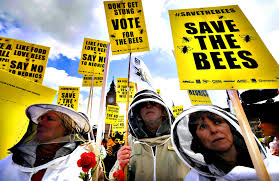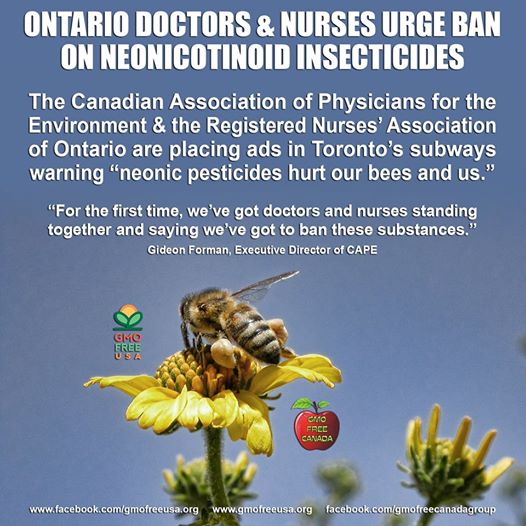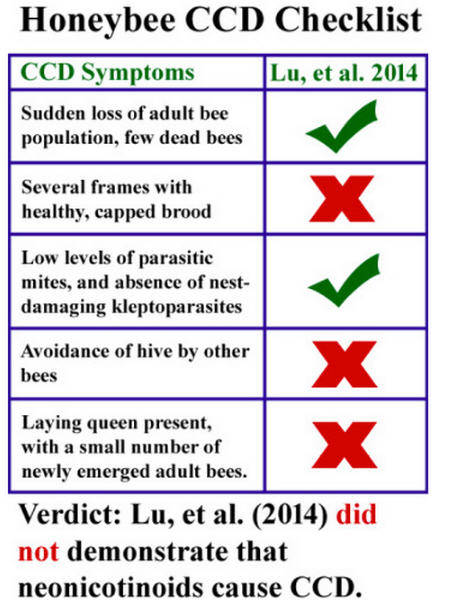Last week, in Part I of this two part series, "Bee Deaths Mystery Solved? Neonicotinoids (Neonics) May Actually Help Bee Health”, we explored the claims by Harvard School of Public Health researcher Chensheng Lu, heralded by anti-pesticide and anti-GMO advocacy groups, for his research that purportedly proves that the class of chemicals known as neonicotinoids are killing bees and endangering humans. And we saw how many journalists, our of ignorance or for ideological reason,s promote dicey science.
In Part II, we examine the specific claim that neonics are responsible for Colony  Collapse Disorder—the centerpiece of Lu’s assertions. We again see how influential media manipulate quotes and selectively present information to ideologically influence trusting readers.
Collapse Disorder—the centerpiece of Lu’s assertions. We again see how influential media manipulate quotes and selectively present information to ideologically influence trusting readers.
And we look at what might happen if neonics are banned, as well as their real impact in agriculture—including intriguing, but incomplete evidence, that when used appropriately the controversial pesticide may actually improve bee health.
Note that every quote from an entomologist or beekeeper was submitted to them for review, as was the entire piece, and changes were made in the few cases the author wanted to tweak their responses to ensure their views were represented accurately and in context.
A week does not go by without one advocacy group or government official or activist scientist making sensational claims about the supposed catastrophic dangers that neonics supposedly present.
Just last week, for example, advertisements began appearing across Ontario in Canada warning, “neonic pesticides hurt our bees and us,” accompanied by a young boy gazing sadly at a dead bee. They were placed by a fringe advocacy group, the Canadian Association of Physicians for the Environment; its primary funder is David Suzuki, a once prominent but now long retired geneticist who more recently has become known for rants against GMO foods.
of Physicians for the Environment; its primary funder is David Suzuki, a once prominent but now long retired geneticist who more recently has become known for rants against GMO foods.That kind of hyperbole, scientists say, obscures the complex story of what’s really happening to bees and why—and the risks of advocacy groups and activist journalists driving science and agricultural regulations into a policy ditch.
Which brings us back to the curious case of Alex Lu.
Although Lu’s most recent paper, published last spring, was not clear on this point, the nutritionist has publicly maintained that neonic seed treatments are the driving cause of CCD. Let’s be clear. Neonics are an appropriate subject for serious research. They are neurotoxic pesticides. Because they rely on a complex set of behaviors, bees exposed to high volumes could conceivably become drunk and ill. Scientists are and should continue to examine this chemical and all agricultural chemicals.
But the emphasis of many popular articles, and Lu's study, is way out of whack with the potential dangers that scientists believe are presented by neonics. The pesticide is applied to seeds sparingly—only about 1-3 ppb is commonly found in pollen or nectar after application, levels way below safety concerns. Plants grown from a treated seed often need no further insecticidal treatment, unlike many competing chemicals. And in contrast to earlier generation insecticides that required multiple applications, when infestations are severe a single additional spraying generally suffices.
Lu steadfastly claims that bees that died in his studies were fed field realistic levels doses—statements echoed by reporters without, it turns out, cross checking with beekeepers or entomologists. “Chensheng Lu and his team treated 12 colonies with tiny levels of neonics,” Mother Jones maintained.
Tiny?
As beekeeper Randy Oliver wrote on his Scientific Beekeeping blog, Lu fed his test colonies a pesticide brew of about 135 parts per billion (ppb). That’s 100 times higher then the 1-3 ppb commonly found in pollen or nectar, a level far below safety concerns. Rather than citing the chemicals’ ppb, some reporters touted the physical size of the dose, a worthless measurement. Lu also fed bees every week for 13 straight weeks when the real world application is just a few weeks at most.
“It’s hard to imagine anyone even reviewed this paper,” Oliver concluded.
What’s remarkable, numerous scientists and beekeepers told me, is that Lu’s bees didn't just keel over in the first few weeks after sucking down what amounted to a lethal cocktail every day.
“It’s surprising those colonies lasted so long given the stratospheric quantities of insecticide [Lu] pumped into them for 13 weeks,” wrote Jonathan Getty on Bee-L Chat, a discussion forum for bee experts. “Lu has convincingly demonstrated, again, as in his previous study … that a high dose of an insecticide will kill an insect. Has anyone learned anything from all this? Looks like junk science at its worst.”
There was also scant evidence to back up Lu’s central claim that he had solved the mystery of CCD. “His description of the hives just didn’t show that,” University of Maryland entomologist Dennis vanEngelsdorp told me. Bee die offs, he said, have occurred mysteriously and periodically since at least the mid-19th century but became the focus of widespread public concern only in 2006. It’s clear that what Lu observed—bee deaths—“was not CCD. Looks like a typical bee colony death over the winter—which often includes bees abandoning the hive—but it’s a slow dwindle not a sudden collapse.”
Joe Ballenger, an entomologist writing for the independent sustainability site Biology Fortified, outlined how little Lu appears to know about CCD. “There are very important differences between the colonies Lu poisoned with insecticide and those which have been affected by CCD,” Ballenger wrote. “Despite these differences, Lu claims he has replicated CCD. However, his data demonstrates that he did not replicate CCD.”
Ballenger drew up a chart of his mistakes.

Are there any prominent entomologists who endorse Lu’s findings? I couldn't find any. Mother Jones quoted Jeffrey Pettis, an entomologist and research leader at USDA’s Beltsville’s Bee Laboratory, as appearing to be supportive. “Pettis told me that he thought Lu's study ‘adds to the list’ of studies showing that pesticides pose a significant threat to honeybees,” Tom Philpott wrote.
I emailed Pettis about that quote:
I was trying to be diplomatic when I talked to Philpott but the Lu study should not have been published. It is not good science. I was trying to say that it adds to the list that pesticides and bees don’t mix but it is not a paper that shows that neonics cause problems simply because it was poorly replicated with high dosages used.
So what was going on in the hives that Lu monitored? The bee deaths that Lu found suggest a quite different cause, said vanEngelsdorp; the bees appear to have been killed by Lu himself—entirely expected if hives are overdosed during a frigid winter.
Are there potential advantages to using neonics to control pest infestations?
A telling fact emerges when you view the landscape of studies about neonics: on the whole, those done in a laboratory or that use unrealistic high doses (e.g. Lu’s studies) raise precautionary concerns. In contrast, field observations show few if any serious problems.
The latest example? Four Canadian scientists led by Cynthia D. Scott Dupree, an environmental biologist at the University of Guelph, undertook a large-scale study of honey bee exposure to one neonic, clothianidin, which is applied as a seed treatment. The study was centered in southern Ontario, which advocacy groups have contended has been particularly hard hit by neonic-related bee deaths.
Designed in cooperation with the US Environmental Protection Agency and Health Canada, it was industry funded, but executed under Good Laboratory Practice Standards.
The scientists observed bees foraging heavily on the canola. As numerous other studies have suggested, they found, “Although various laboratory studies have reported sublethal effects in individual honey bees exposed to low doses of neonicotinoid insecticides, the results of the present study suggest that foraging on clothianidin seed-treated crops, under realistic conditions, poses low risk to honey bee colonies.”
Assertions by entomologists that neonics play a limited role in bee health infuriates some environmentalists convinced this mystery is solved: Let's just ban neonics, they say, and move on.
"For its part, the pesticide industry is doing its best to shroud the phenomenon in uncertainty,” Mother Jones wrote in its article hyping the Lu study, “promoting a ‘multifactorial’ explanation that points the finger at mites, viruses, and ‘many other factors, but not…the use of insecticides,’ as neonic producer Bayer puts it in its ‘Honey Bee Health’ pamphlet."
But it’s not Bayer making those claims, as Philpott seemed to suggest; it’s independent and government scientists. Noting the complexity of the phenomenon, the US Department of Agriculture and the Environmental Protection Agency took a cautious, science-based approach to the emerging controversy three years ago, commissioning a broad-based assessment of the evidence. This panel, reflecting views by most commercial beekeeping and academic experts, concluded that neonics were unlikely to be the major driver of bee deaths.
Rather, the experts identified instead a complex set of causes likely linked to a surge in pathogens, such as Varroa mites that feed on the bodily fluids of bees and which first surfaced in the US in the 1980s and began infesting beehives in California in 1993; and Nosema, a common parasite that invades their intestinal tracts; and the use and perhaps misuse of miticides to control them. Other issues include the stress put on bees by large commercial beekeepers, particularly to service the agri-business demand for bees needed for the California almond crop in late winter before bees normally repopulate, as well as climate change and breeding issues.
Few experts or practitioners believe banning neonics or GMOs would improve bee health and could in fact result in farmers going back to spraying insecticides known to harm pollinators and humans.
"If we took pesticides out of the equation tomorrow, I think there's no doubt we would have reduced colony losses,” vanEngelsdorp told me. "But even without pesticides, we'd still be seeing significant losses—losses that are unsustainable."
Neonics present in corn dust at planting have been shown definitively to contribute to bee mortality, but that’s a result of faulty formulation, scientists have concluded. When used properly, there is intriguing evidence that neonics may actually improved bee health in some circumstances. Hints can be found, ironically, in Alex Lu’s own data, of all places.
Lu's 2012 paper raises red flags because he used two separate dosing regimens as the experiment progressed, noted Richard Cowles, a prominent entomologist with the state of Connecticut, in an email to me. During the first four weeks, the bees were fed concentrations of imidacloprid that, as it turns out, were in fact field realistic. At three weeks into testing using these concentrations, the health of the bee colonies was positively correlated with exposure to imidacloprid, as measured by the number of capped brood cells. The bees appeared healthier. "Rather than continue the experiment with these concentrations, Dr. Lu inexplicably increased the dosages for the last nine weeks of feeding--by 40 times,” Cowles told me.
Why?
Cowles couldn't get an answer from Lu and neither could I. This is one of the many questions that I had hoped to put to Lu in an interview. He at first agreed but then stopped communicating. I contacted him again after the posting of Part I of this series, and also reached out to the Harvard School of Public Health, but got no reply.
Entomologists have volunteered as to what they thought might have been going on when Lu changed feeding tactics. “Dr. Lu probably was trying to hide the fact that he observed an unexpected result contrary to his expectations, which led to him increase the dosages to poison the bees,” Cowles, emailed me. “Whether this sub-lethal effect is actually therapeutic to honey bees is a very interesting question, and one that I’d like to investigate.”
In other words, Lu’s data suggests the opposite of his stated conclusion—bees appear to do fine when exposed to field realistic doses and even increasingly higher amounts of neonics, but ultimately succumb to astronomical levels.
This is not the first time a neonic study has shown that bee health might improve when crops are treated with new generation insecticides. In a 2013 PLOS ONE study, a team led by vanEngelsdorp and Jeffrey Pettis studied the real world impact of 35 pesticides including three neonics—acetamiprid, imidacloprid and thiacloprid—by examining hives from seven major crops. Intriguingly, bee health improved although the results would need to be confirmed with follow up research. This study remains the only lab research to date that has evaluated how real world pollen-pesticide blends affect honey bee health.
The researchers found a striking reduction in the risk from Nosema infection when neonics were used--bee health improved. Why would that be? It seems neonics may suppress the parasite associated with the disease. vanEngelsdorp and Pettis are not yet sure this is a real effect; good science requires that results be confirmed in multiple studies. That said, the intriguing but startling finding directly challenges the belief that neonics pose an unusually unique danger to bees.
What is the future for bees, neonics and agriculture?
Are there replacement insecticides if neonics should be banned? Sure. Those based on pyrethroids and organophosphates some of which are more toxic to bees and humans, are not as effective as neonics for many uses—and are not in the political crosshairs.
That’s not slowed demands for an immediate ban. Advocacy groups recently widened the scope of their concerns, claiming neonics could have an unknown environmental impact, and waterways are being polluted. But evidence for that is scant. A US Geological Society study published in July found the highest levels detected were at least 40 times lower than benchmarks established by EPA to be protective of aquatic life, and most were up to 1,000 times below that level.
What would happen if US officials do institute sharp restrictions, as the White House may be contemplating?
Neonics are not only important to major row crops such as corn, soy and canola, they also remain the most effective weapon against Asian psyllid, an insect that spreads the deadly virus that threatens America’s citrus crop. They are the key pesticide keeping in check whitefly infestations, which could otherwise devastate winter vegetables. They are the primary insecticide used to counter leafhoppers in the grape-growing Northwest as well as thrips in cotton and water weevil in rice. They’ve been hugely successful in combating aphids and beetles in potatoes.
I found scant support among entomologists for the two-year precautionary moratorium adopted by European politicians in the wake of near hysterical media reports in 2012 and 2013, many generated by coverage of Lu’s research. That ban looks like a textbook case of “shooting before you aim,” resulting in unintended but predictable consequences. As Matt Ridley reported earlier this month in The Times of London:
All across southeast Britain this autumn, crops of oilseed rape are dying because of infestation by flea beetles. The direct cause of the problem is the two-year ban on pesticides called neonicotinoids brought in by the EU over British objections at the tail end of last year. … Farmers in Germany, the EU’s largest producer of rape, are also reporting widespread damage. Since rape is one of the main flower crops, providing huge amounts of pollen and nectar for bees, this will hurt wild bee numbers as well as farmers’ livelihoods.
There are now growing concerns that Lu’s studies will carry weight with politicians facing pressure to “do something”. In September, a coalition of environmental groups co-wrote a letter signed by 60 Congressional Democrats urging the EPA to restrict neonicotinoid use citing Lu’s work in arguing that “native pollinators” have “suffered alarming declines.”
Those calls send chills down the back of entomologists concerned that Lu’s claims that he has solved the mystery of the beemageddon that doesn’t actually exist will have a chilling impact on public policy.
“Lu’s work is clearly biased, sensational,” said Richard Cowles. “It is horrendously incompetent. This is just hogwash. We will all pay a price for bad research.”
May Berenbaum was appointed this past summer to chair a major National Academy of Sciences study on the health of pollinators ordered by the White House. I asked her if there is anything of value in Lu’s study to guide scientists and regulators? Do neonicotinoids threaten the health of this beleaguered arthropod?
Berenbaum paused. A dedicated environmentalist, she is known for her understated fairness.
“I’m no fan of pesticides and they are overused in agriculture, but you won’t find any confirmation of that in this study.”
Science is not a set of results; it is a method. If the method is wrong, the results are useless. The uncomfortably high number of bee deaths eludes the kind of definitive but potentially reckless conclusion that could result in precipitous regulations.
“This is a really complex issue with no quick and easy solutions,” Berenbaum said. “I can’t imagine a situation in which I would cite the findings of this paper as rigorous and reliable. This is just not good science.”
Jon Entine, executive director of the Genetic Literacy Project, is a senior fellow at the World Food Center Institute for Food and Agricultural Literacy at the University of California-Davis and the Center for Health&Risk Communication at George Mason University. Follow Jon on Twitter @JonEntine




Comments